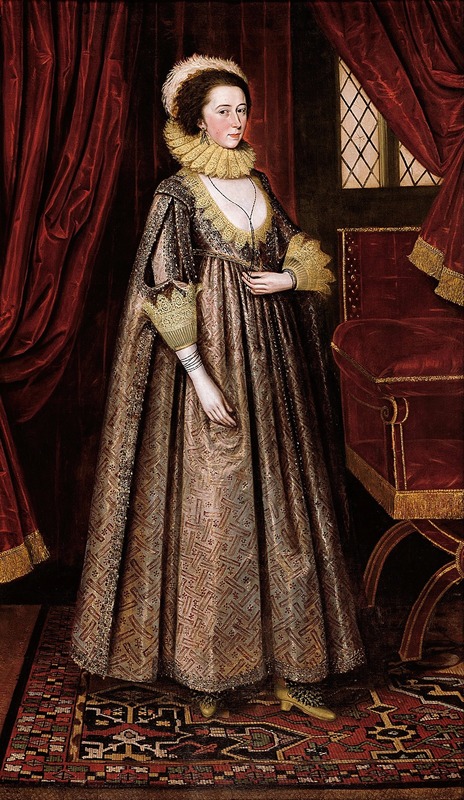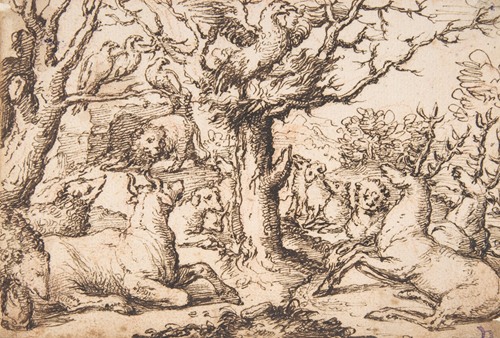
Marcus Gheeraerts the Elder, Marc Gerard and Marcus Garret was a Flemish painter, draughtsman, print designer and etcher who was active in his native Flanders and in England. He practised in many genres, including portraits, religious paintings, landscapes and architectural themes. He designed heraldic designs and decorations for tombs. He is known for his creation of a print depicting a map of his native town Bruges and the illustrations for a Dutch-language publication recounting stories from Aesop's Fables. His attention to naturalistic detail and his practice of drawing animals from life for his prints had an important influence on European book illustration. His son Marcus the Younger became a prominent court painter at the English court.
Marcus Gheeraerts the Elder was born in Bruges, Flanders, as the son of Egbert Gheeraerts and his wife Antonine Vander Weerde. Egbert Gheeraerts was a painter who had moved from an unknown location to Bruges. Some scholars believe that Gheeraerts' patronymic indicates that he likely came from the Northern Netherlands. His wife Antonine, on the other hand, was a native of Bruges. Egbert became a master of the Guild of Saint Luke of Bruges on 20 January 1516.
The exact date of birth of Marcus Gheeraerts is not known. On the basis of archival sources about the life of his father, it can be deduced that he was born between 1516 and 1521. Not long after her husband's death, Marcus' mother remarried Simon Pieters, who was also a painter and probably a native of the Northern Netherlands. The couple had six children with whom Marcus was raised. This explains why he was sometimes referred to as Marcus Pieters. After the death of his stepfather Simon Pieters in early 1557, Marcus Gheeraerts became the guardian of his half-brothers and sisters. Marcus's mother died on 8 August 1580.
The master or masters of Marcus Gheeraerts are not known. The most obvious candidate is his stepfather Simon Pieters. Art historians believe that he started his training with Simon Pieters and later worked in the workshop of his guardian Albert Cornelis. It is speculated that he may have had other masters but there is no agreement as to their identity. He likely trained outside Bruges to learn the craft of engraver, which was not generally practised at a high level in Bruges.
There is no information about Gheeraerts in the registers of the Sint-Lucas guild in Bruges for the period from 1522 to 1549. This absence has been interpreted as an indication that he left his hometown to study in Antwerp or abroad. From 1558 onwards a number of documents demonstrate that Gheeraerts was resident in Bruges. On 31 July 1558, he entered the artisan and saddle maker's guild of Bruges as a master painter. In the same year, he was elected second board member of the guild, suggesting that he already enjoyed considerable professional recognition. From April to September 1561 Gheeraerts was the first board member.
On 3 June 1558, Marcus Gheeraerts married Johanna Struve. The couple had three children, of whom two are known by name, a son later referred to as Marcus the Younger and a daughter called Esther. A third child died at a young age and was buried in 1561.
Gheeraerts developed a professional career as a painter, etcher and designer. He was active as a designer of heraldic motifs. On 10 September 1559, he was commissioned to provide designs for the tombs of Mary of Burgundy and Charles the Bold in the Church of Our Lady in Bruges. He drew the patterns for the lavishly decorated metal ornaments, the colorful coats of arms and two copper angels that were attached to the sides of the tombs. In 1561 Marcus Gheeraerts was commissioned to complete a triptych of the Passion of Christ that had been commenced by the prominent painter Bernard van Orley. The painting had remained unfinished after van Orley's death in 1542. Originally intended for the church of the monastery of Brou near Bourg-en-Bresse (Ain department, France), which Margaret of Austria had built, the triptych was transferred to Bruges after her death. Gheeraerts completed it. Margaret of Parma later decided to place the triptych in the Church of Our Lady in Bruges.
Gheeraerts was further commissioned in 1561 to make a print depicting a map of his hometown. He completed the work in one year. The map is one of the earliest examples of a perspective city map that is correctly displayed. It is during this period that Gheeraerts most likely painted the Triumphant Christ (collection of the Memling museum in Old St. John's Hospital in Bruges).
Marcus Gheeraerts became involved in the Calvinist community in Bruges and became a leader of the local church community. Whereas Calvinism was initially tolerated, the religious persecution of Calvinists commenced in 1567 with the arrival of new governor of the Low Countries, the Duke of Alva. In 1566 he participated in protests against the arrest of Calvinists in Bruges. He reflected in his art on the religious turmoil and iconoclasm of his time. As a Calvinist and artist he seemed to have had mixed feelings about the Iconoclasm of his religious group: he condemned idolatry of images but did not agree with the wholesale destruction of religious images by the Iconoclasts. In 1566 or shortly after, he created a print referred to as the Allegory of Iconoclasm that shows a composite rotting head of a monk. The head appears to rise up from a rocky outcropping. Myriad little figures swarm over the rocks. They enact 22 different scenes that used to be denoted by alphabetical keys which have not survived. Inside the gaping mouth a diabolical mass is celebrated. On the pâté of the head sits a pope-like figure under a canopy on a throne surrounded by bishops and monks. Indulgences and rosaries are pinned up on the staves and various rituals and processions take place and are labelled with letters. In the foreground Protestant iconoclasts are smashing altarpieces, religious sculptures, other church-related items and hurling them into a fire. The print is a condemnation of Catholic idolatry in all its forms and shows the Calvinists as cleansing the world of this perceived evil. Gheeraerts is believed to have followed up this print with more politically tainted prints, which resulted in 1568 in a prosecution for producing caricatures of the pope, the king and Catholicism.
Fearing that he would be condemned to death in the criminal proceedings against him, Gheeraerts fled in 1568 to England with his son Marcus and his workshop assistant Philipus de la Valla. His wife and daughter remained in Bruges. The verdict in his case was pronounced at the end of 1568. He was convicted and the punishment was permanent banishment and forfeiture of his entire fortune.
Gheeraerts took up residence in London upon his arrival in England in 1568. He was joined by his daughter in May 1571 likely after her mother had died. After the death of his wife in Bruges, the artist married in England his second wife, Sussanah de Critz. His wife was a sister of Queen Elizabeth I's serjeant-painter, John de Critz, another Flemish painter who had fled to England. The couple had two daughters and one son. The only child surviving into adulthood, Sarah, later married the famous French-born English limner Isaac Oliver. Just as before in Bruges, Gheeraerts made drawings and etchings and continued his painting activities. As there was a keen demand for portrait paintings in England, Gheeraerts started to paint portraits, which he had not done while still in Flanders.
Art historians do not agree as to whether Gheeraerts returned to his native Flanders around 1577 to continue his career in Antwerp. In 1577 a 'Mercus Geeraert Painter' was registered as a master in the Guild of Saint Luke of Antwerp and paid registration fees for the years 1585 and 1586. It is not clear whether this Mercus referred to Marcus the Elder or to Marcus the Younger. Some art historians believe that Marcus the Elder registered in the Antwerp Guild in order to be able to legally work with Antwerp printers for the publications on which he worked. Others believe that he actually worked in Antwerp and point to the various publications printed in Antwerp on which he collaborated.
Marcus Gheeraerts had various pupils during his career. In 1563, 13-year-old Melchior d'Assoneville became an apprentice of Gheeraerts in Bruges. Melchior d’Assoneville later became a sculptor and decorative painter and while living in Mechelen he was the master of Hendrik Faydherbe. His workshop assistant Philipus de la Valla who fled with him to England may also have been a pupil of Gheeraerts although he is sometimes referred to in contemporary records as a servant. It is not certain whether Marcus Gheeraerts the Elder was the teacher of his son Marcus the Younger. There are different views on this, but it is likely that he was but that his son also received training with other artists, who may have included other Flemish emigrants in England, such as Lucas de Heere and John de Critz.
The date of death of Gheeraerts is not known but it must have been before 1599.

